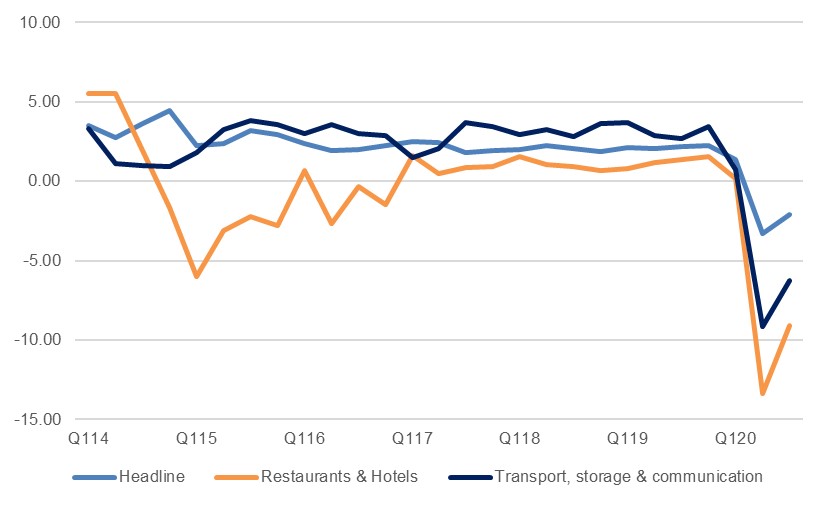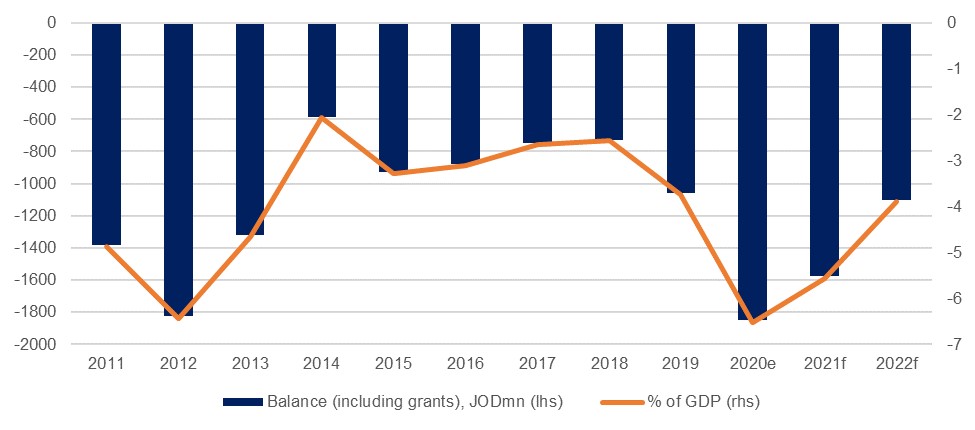
Having come through 2020 comparatively less scathed than some of its MENA peers, we expect a modest ongoing improvement in Jordan’s economy in 2021, provided the Covid-19 pandemic starts to abate both locally and globally as expected. Growth should turn positive once again, and we project that the country’s twin deficits, which both widened last year, should narrow modestly once more. This will be a gradual process however, with the focus on supporting growth for the time being.
Having had a high level of success in containing the coronavirus in the first instance through an early and comprehensive lockdown, Jordan subsequently saw a ramp-up in cases later in the year, hitting its peak of a seven-day moving average of 5,553 in November. The resurgence in cases in the fourth quarter leads us to believe that the slowdown seen in the economic contraction in Q3 (-2.2%, compared to -3.6% in Q2) reversed moderately; we estimate a fourth quarter growth rate of -2.4% y/y which leads us to our 2020 estimate of -1.7%. If realised, this would represent Jordan’s first economic contraction in decades. The industrial production data for October (-12.3% y/y) and November (-11.2%) were significantly worse than the Q3 average of -1.8% (but at the same time far stronger than the Q2 average of -34.0%), underpinning our estimate of a bigger Q4 GDP contraction.
 Source: Haver Analytics, Emirates NBD Research
Source: Haver Analytics, Emirates NBD Research
Looking at the GDP data over the first three quarters of 2020, the sectors most affected were those most directly affected by lockdowns the world over, namely wholesale & retail trade (down -4.6% y/y in Q2) and restaurants and hotels (-13.4%). As global trade slowed, so did the transport, storage & communication component of GDP, which usually makes up around 9.0% of total output. It contracted -9.2% in Q2 and -6.3% in Q3. While cases have come down again sharply since the November peak – 851 for the latest reading of January 23 – until there has been a comprehensive vaccination programme, the risk remains that renewed restrictions on activity will be implemented, presenting a potential drag on activity.
The tourism sector, one of the lynchpins of the Jordanian economy, will also remain under pressure until the pandemic is brought under control both in Jordan and around the world. Tourism contributed 15.8% of GDP in 2019, according to the World Travel & Tourism Council, and provided 17.7% of all employment. Over January-October last year, visitor arrivals to Jordan were down 76.0% compared to the previous year, and this has contributed to a rise in unemployment to a record 24% according to the IMF. A strong recovery in international tourism would provide a boost to Jordanian growth in 2021, but at present it looks unlikely that the first half will be especially robust as key source market Western Europe is struggling with elevated new caseloads and more stringent restrictions on travel. Nevertheless, with these ongoing pressures expected to dissipate by the second half, we are confident that Jordan will return to growth in 2021, forecasting an expansion of 3.0%.
The collapse in tourism in 2020 has also weighed on Jordan’s external and fiscal positions, as receipts were down 72.0% y/y over the first three quarters, with a similar proportional collapse in travel payments doing little to offset this drop. Despite a fairly substantial fall in goods imports going some way to mitigating similar losses from exports, we estimate that the current account deficit widened to -4.9% of GDP, from -2.1% the previous year. As tourism picks up again later this year we anticipate a gradual improvement in the external position, with the deficit narrowing to -4.2% of GDP.
In March 2020, Jordan agreed a new USD 1.3bn Extended Fund Facility with the IMF to help it weather the storm, and the Fund’s first review of the arrangement in January reiterated its support for the country, even as the extraordinary circumstances had led to a forced recalibration of some of the original programme targets.
 Source: Haver Analytics, Emirates NBD Research
Source: Haver Analytics, Emirates NBD Research
Jordan’s fiscal position has also weakened, and we estimate the budget deficit widened from -3.7% of GDP in 2019 to -6.5% last year. Current expenditures have risen as the state has been forced to provide more support for those affected by the Covid-19 pandemic and its effect on the economy. In 2021 we project that the deficit will narrow moderately to -5.6%, with the IMF’s advice being for ‘gradual and growth-friendly consolidation.’ The government aims to tackle tax evasion in a bid to bolster its inflows.